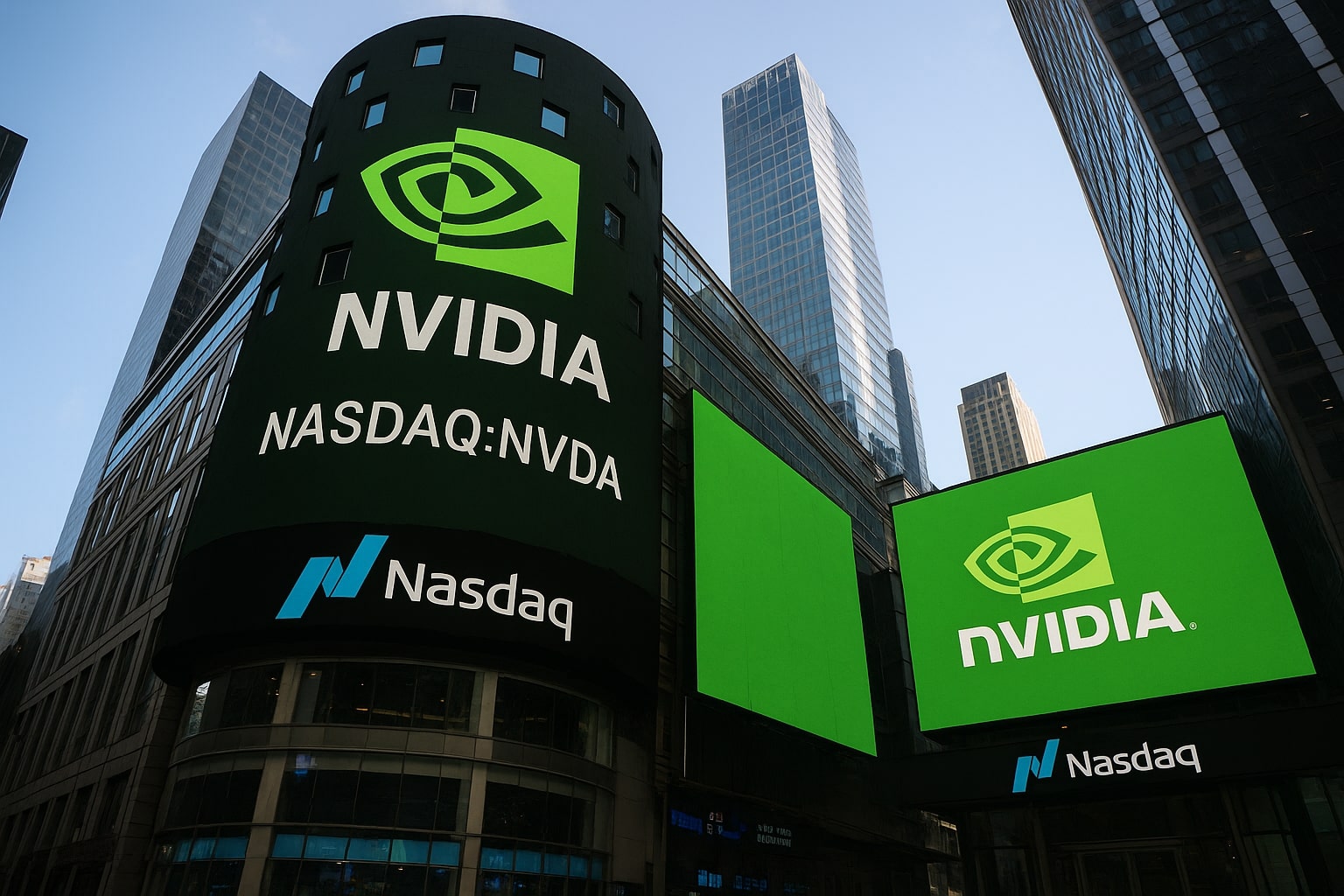NVIDIA Corporation (NASDAQ:NVDA) Analysis: AI Supremacy, China Risk, and Multi-Sector Expansion
Revenue Acceleration and Record Margins for NASDAQ:NVDA
NVIDIA (NASDAQ:NVDA) closed the last week of August at $174.18, down 3.3% on the day, but the earnings backdrop continues to redefine expectations. Q2 revenue came in at $46.74 billion, up 55.6% year over year, while diluted EPS hit $1.05, climbing 54.4% from the prior year. Data center revenue, the cornerstone of NVIDIA’s AI franchise, accounted for $41.1 billion, representing 56% growth YoY and 5% sequential expansion. Gaming contributed $4.3 billion, up 49% YoY, while automotive and robotics segments accelerated on Jetson Thor shipments. Gross margins stood at 72.7%, with management guiding for margins to rise to 73.5% in Q3, and operating cash flow was a massive $15.36 billion, even after a one-off $8 billion tax payment. NVIDIA also announced a $60 billion share buyback program, underlining its capacity to return capital alongside hyper-growth.
Q3 Guidance and EPS Trajectory
Guidance for Q3 set revenue expectations at $54 billion (+/- 2%), comfortably ahead of Wall Street’s $52.76 billion consensus. Non-GAAP EPS is projected to trend toward $1.30 in Q3, with forward twelve-month EPS modeled at $5.85–$5.86 using ARIMA-based projections. Analysts currently assign NVIDIA a forward P/E of 39x, implying a price target range of $210–$236, representing 20–35% upside from current trading levels. Despite a trailing P/E near 49.6x, the stock’s 52.4% net margin and 60.8% operating margin more than justify the premium compared to semiconductor peers.
China Headwinds and the H20 Export Dynamics
China remains a flashpoint. The inability to ship a single H20 chip during the quarter cost NVIDIA roughly $4 billion in lost sales. Management has stated Q3 guidance does not include Chinese H20 shipments, though CFO Colette Kress hinted that between $2–5 billion in H20 revenue could materialize if restrictions ease. CEO Jensen Huang suggested Blackwell shipments to China are a “real possibility,” reflecting confidence in demand readiness. China represented 12.5% of NVIDIA’s Q1 2026 turnover, making it both a growth lever and geopolitical risk factor. The U.S. government’s revenue-sharing export framework offers NVIDIA a controlled re-entry into the market, potentially boosting revenues while containing Huawei’s ability to expand its CANN ecosystem.
CUDA Ecosystem and Software Lock-In
Beyond hardware, NVIDIA’s moat lies in its CUDA architecture, which commands over 90% market share in AI frameworks. CUDA has become the operating system of AI computing, locking in hyperscalers, enterprises, and sovereign buyers alike. The expansion into CUDA-X libraries for industries such as quantum, genomics, and 5G ensures that NVIDIA remains embedded in applications far beyond generic compute. This software dominance explains why gross margins consistently exceed 70%, compared to AMD’s mid-40% range, and ensures a premium pricing model across hardware generations. Blackwell architecture has already seen 2x performance improvements since launch, and Rubin GPUs are expected to extend efficiency multiples further into 2026–2027.
Sovereign AI, Gaming, and Automotive Growth Engines
Sovereign AI has emerged as a second megatrend. NVIDIA disclosed it is on track to generate $20 billion in sovereign AI revenue this year, more than double 2024 levels. Governments across the U.S., EU, China, and Middle East are investing billions to build national AI infrastructure, treating NVIDIA as a strategic partner. Gaming revenue reached $4.3 billion in Q2, bolstered by Blackwell’s integration into GeForce NOW, pointing to momentum as cloud gaming demand expands. Automotive and robotics added further diversity, with Jetson Thor deployments scaling across 2 million developers and 1,000+ hardware partners. These adjacencies ensure that even if hyperscaler spending moderates, NVIDIA has multi-pronged demand drivers across sovereigns, consumers, and industrial AI.
Valuation Compared to Peers
At a market cap of $4.24 trillion, NVIDIA dwarfs peers, yet valuation remains defensible. The stock trades at 25.9x price-to-sales and 40.6x EV/EBITDA, compared to AMD’s ~48x EV/EBITDA despite only projecting 21% EBITDA growth versus NVIDIA’s ~70% growth rate. Advanced Micro Devices, Broadcom, and Intel lack the CUDA ecosystem, leaving NVIDIA as the only true end-to-end AI compute provider. Analyst price targets cluster between $210 and $236, with Rosenblatt suggesting upside to $200 billion in revenue by decade’s end, underpinned by Huang’s forecast of $3–4 trillion AI infrastructure spend by 2030.
Financial Strength and Cash Generation
NVIDIA reported $165.2 billion in TTM revenue and $86.6 billion net income, making it one of the most profitable corporations globally. Free cash flow stood at $77 billion, with $56.7 billion in cash reserves versus only $10.6 billion in debt, resulting in a debt-to-equity ratio of just 10.6%. Return on equity soared to 109.4%, while return on assets reached 53%, metrics rarely seen in semiconductors. With liquidity and balance sheet resilience this strong, the company’s ability to fund innovation cycles while rewarding shareholders is virtually unmatched.
Institutional Positioning and Insider Transactions
Institutions hold roughly 69% of float, with insider ownership at 4.3%, unusually high for a mega-cap. Insider transactions have been active in 2025, with sales tied primarily to scheduled programs rather than sentiment shifts. Short interest is minimal at 0.88% of float, reflecting limited bearish conviction. The stock split 10-for-1 in June 2024 expanded retail participation, helping fuel one of the broadest investor bases in the market.
Risk Factors Beyond China
While China headlines dominate, risks extend to hyperscaler strategies. Microsoft and Amazon are designing their own AI chips, raising the possibility of reduced dependency on NVIDIA’s GPUs. A mismatch between AI infrastructure build-out and enterprise application adoption could also lead to underutilized compute capacity, temporarily weighing on revenue growth. Competition from Huawei, AMD, and custom ASICs cannot be dismissed, but none currently rival NVIDIA’s combination of hardware, networking, and software.
Verdict on NVIDIA (NASDAQ:NVDA)
NVIDIA at $174 per share trades well below analyst consensus targets above $210, with a forward P/E of 39x that looks modest relative to 52% net margins and ~70% EBITDA growth. With sovereign AI, gaming, and robotics adding to hyperscaler demand, CUDA cementing software lock-in, and a balance sheet that allows $60 billion in buybacks alongside heavy R&D, NVIDIA remains structurally dominant in AI infrastructure. The real-time chart shows short-term volatility, but the fundamentals overwhelmingly support upside. Based on execution, margins, and demand outlook, NASDAQ:NVDA is a BUY, with a near-term path to $210–$236 and long-term potential far beyond as AI infrastructure scales globally.



















